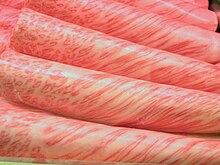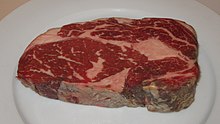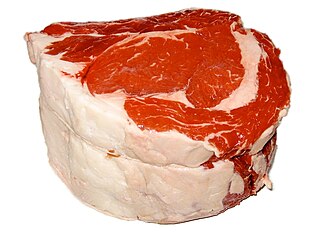
Marbled meat is meat, especially red meat, that contains various amounts of intramuscular fat, giving it an appearance similar to marble.
Contents



Marbled meat is meat, especially red meat, that contains various amounts of intramuscular fat, giving it an appearance similar to marble.


Beef quality grades - A quality grade is a composite evaluation of factors that affect palatability of meat (tenderness, juiciness, and flavor). These factors include carcass maturity, firmness, texture, and color of lean, and the amount and distribution of marbling within the lean. Beef carcass quality grading is based on (1) degree of marbling and (2) degree of maturity. [1]
Marbling - (intramuscular fat) is the intermingling or dispersion of fat within the lean. Graders evaluate the amount and distribution of marbling in the ribeye muscle at the cut surface after the carcass has been ribbed between the 12th and 13th ribs. Degree of marbling is the primary determination of quality grade. [1]
Maturity refers to the physiological age of the animal rather than the chronological age. Because the chronological age is virtually never known, physiological maturity is used; the indicators are bone characteristics, ossification of cartilage, and the color and texture of ribeye muscle. Cartilage becomes bone, lean color darkens and texture becomes coarser with increasing age. Cartilage and bone maturity receives more emphasis because lean color and texture can be affected by other postmortem factors. [1]
Beef yield grades - In beef, yield grades estimate the amount of boneless, closely trimmed retail cuts from the high-value parts of the carcass–the round, loin, rib, and chuck. However, they also show differences in the total yield of retail cuts. We expect a YG 1 carcass to have the highest percentage of boneless, closely trimmed retail cuts, or higher cutability, while a YG 5 carcass would have the lowest percentage of boneless, closely trimmed retail cuts, or the lowest cutability. The USDA Yield Grades are rated numerically and are 1, 2, 3, 4, and 5. Yield Grade 1 denotes the highest yielding carcass and Yield Grade 5, the lowest. [1]
The USDA's grading system, which has been designed to reward marbling, has eight different grades; Prime, Choice, Select, Standard, Commercial, Utility, Cutter and Canner. Prime has the highest marbling content when compared to other grades, and is capable of fetching a premium at restaurants and supermarkets. Choice is the grade most commonly sold in retail outlets, and Select is sold as a cheaper option in many stores. Prime, Choice, Select and Standard are commonly used in the younger cattle (under 42 months of age), and Commercial, Utility, Canner and Cutter are used in older cattle carcasses which are not marketed as wholesale beef "block" meat, but as material used in ground products and cheaper steaks for family restaurants. [2]

The Belgian Blue is a breed of beef cattle from Belgium. It may also be known as the Race de la Moyenne et Haute Belgique, or dikbil. Alternative names for this breed include Belgian Blue-White; Belgian White and Blue Pied; Belgian White Blue; Blue; and Blue Belgian. The Belgian Blue's extremely lean, hyper-sculpted, ultra-muscular physique is termed "double-muscling". The double-muscling phenotype is a heritable condition resulting in an increased number of muscle fibres (hyperplasia), instead of the (normal) enlargement of individual muscle fibres (hypertrophy).

Beef is the culinary name for meat from cattle.

A beefsteak, often called just steak, is a flat cut of beef with parallel faces, usually cut perpendicular to the muscle fibers. In common restaurant service a single serving has a raw mass ranging from 120 to 600 grams. Beef steaks are usually grilled, pan-fried, or broiled. The more tender cuts from the loin and rib are cooked quickly, using dry heat, and served whole. Less tender cuts from the chuck or round are cooked with moist heat or are mechanically tenderized.

Brisket is a cut of meat from the breast or lower chest of beef or veal. The beef brisket is one of the nine beef primal cuts, though the definition of the cut differs internationally. The brisket muscles include the superficial and deep pectorals. As cattle do not have collar bones, these muscles support about 60% of the body weight of standing or moving cattle. This requires a significant amount of connective tissue, so the resulting meat must be cooked correctly to tenderise it.
Ground beef, minced beef or beef mince is beef that has been finely chopped with a knife, meat grinder, mincer or mincing machine. It is used in many recipes including hamburgers, bolognese sauce, meatloaf, meatballs and kofta.

Beef aging or ageing is a process of preparing beef for consumption by aging it, in order to break down the connective tissue within the meat.

Salisbury steak is a dish originating in the United States and made from a blend of ground beef and other ingredients and usually served with gravy or brown sauce. It is a version of Hamburg steak.

The rib eye or ribeye is a boneless rib steak from the rib section.

Skirt steak is a cut of beef steak from the plate. It is long, flat, and prized for its flavor rather than tenderness. It is not to be confused with hanger steak, a generally similar adjacent cut also from the plate.

Pork ribs are a cut of pork popular in Western and Asian cuisines. The ribcage of a domestic pig, meat and bones together, is cut into usable pieces, prepared by smoking, grilling, or baking – usually with a sauce, often barbecue – and then served.

Chuck steak is a cut of beef and is part of the sub-prime cut known as the chuck.

A standing rib roast, also known as prime rib, is a cut of beef from the primal rib, one of the primal cuts of beef. While the entire rib section comprises ribs six through 12, a standing rib roast may contain anywhere from two to seven ribs.
During butchering, beef is first divided into primal cuts, pieces of meat initially separated from the carcass. These are basic sections from which steaks and other subdivisions are cut. Since the animal's legs and neck muscles do the most work, they are the toughest; the meat becomes more tender as distance from hoof and horn increases.

Chicken is the most common type of poultry in the world. Owing to the relative ease and low cost of raising chickens—in comparison to mammals such as cattle or hogs—chicken meat and chicken eggs have become prevalent in numerous cuisines.

Short ribs are a cut of beef taken from the brisket, chuck, plate, or rib areas of beef cattle. They consist of a short portion of the rib bone and the surrounding meat, which varies in thickness. There are two major types of cuts: the "flanken", which is cut across the bone and leaves the bone just 1 to 2 inches or less in length, and the "English", which is cut parallel to the bone and leaves the bone up to 6 inches (15 cm) in length. English cut short ribs may be served individually, or three or four may be served connected to one another. Short ribs are popular in many international cuisines.

A rib steak is a beefsteak sliced from the rib primal of a beef animal, with rib bone attached. In the United States, the term rib eye steak is used for a rib steak with the bone removed; however, in some areas, and outside the U.S., the terms are often used interchangeably. The "rib eye" or "ribeye" was originally, the central portion of the rib steak, without the bone, resembling an eye. The rib steak can also be prepared as a tomahawk steak which requires the butcher to leave the rib bone intact, french trim the bone and leave it at least five inches long. The tomahawk steak resembles the Native American tomahawk axe from which it gets its name.

A primal cut or cut of meat is a piece of meat initially separated from the carcass of an animal during butchering. Examples of primals include the round, loin, rib, and chuck for beef or the ham, loin, Boston butt, and picnic for pork.

Error: imagemap_invalid_image

A steak is a thick cut of meat generally sliced across the muscle fibers, sometimes including a bone. It is normally grilled or fried. Steak can be diced, cooked in sauce, such as in steak and kidney pie, or minced and formed into patties, such as hamburgers.
Countries regulate the marketing and sale of beef by observing criteria of cattle carcasses at the abattoir (slaughterhouse) and classifying the carcasses. This classification, sometimes optional, can suggest a market demand for a particular animal's attributes and therefore the price owed to the producer.
{{cite web}}: CS1 maint: multiple names: authors list (link)